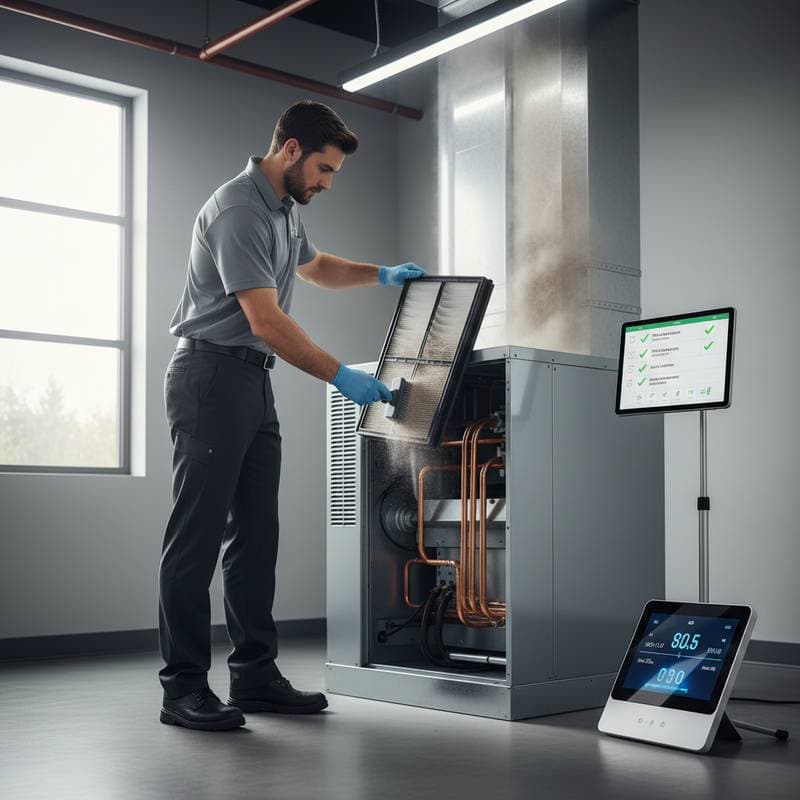Why Spring HVAC Tune-Ups Enhance Indoor Air Quality
Indoor allergies often intensify during spring, and a musty odor might persist despite regular cleaning. These issues frequently stem from an HVAC system that requires maintenance. Scheduling a tune-up in spring aligns with seasonal transitions, such as airing out the home and refreshing linens, to create a noticeably healthier living environment.
Essential Functions of the HVAC System in Air Management
The HVAC system extends beyond temperature control; it actively filters and distributes air throughout the home. Clogged filters trap dust, pollen, and pet dander, which restricts airflow and forces the system to operate inefficiently. Consequently, these contaminants recirculate, compromising air purity over time.
A targeted spring tune-up addresses these components by removing accumulated debris and optimizing performance. This process ensures the system functions as an effective barrier against pollutants, promoting consistent comfort and reducing operational strain as temperatures rise.
Components of a Comprehensive Spring HVAC Tune-Up
Professional tune-ups follow a structured approach, though specifics may vary based on the system. Technicians typically perform the following tasks:
-
Filter Inspection and Replacement
Examine existing filters for blockages and install high-efficiency models that capture fine particles like pollen and mold spores, leading to rapid improvements in air clarity. -
Coil Maintenance
Clean evaporator and condenser coils to eliminate dirt buildup, which enhances heat transfer and prevents the system from circulating excess dust during extended operation. -
Drain Line Clearance
Flush drain lines to remove obstructions that foster moisture and mold. This step eliminates potential sources of odors and microbial growth in the air pathway. -
Blower and Fan Evaluation
Inspect these elements for dust accumulation or misalignment, which can disrupt even air distribution and contribute to temperature inconsistencies or excessive noise. -
Duct Inspection and Sealing
Assess ductwork for leaks that permit pollutant infiltration and energy loss. Sealing identified gaps preserves air quality and system efficiency. -
Thermostat Adjustment
Calibrate the thermostat to maintain precise temperature control, minimizing humidity variations that exacerbate allergen proliferation.
Financial Considerations and Efficiency Gains
Expect to pay between $80 and $200 for a standard tune-up, influenced by home size and equipment complexity. This investment yields tangible returns through reduced energy consumption, potentially lowering cooling costs by 10 to 15 percent. Seasonal savings often offset the initial outlay while extending system longevity.
Regular maintenance also averts costly failures, such as refrigerant issues or coil damage, which demand repairs exceeding $1,000. Viewing the tune-up as proactive care safeguards long-term financial stability.
Tangible Health Improvements from Cleaner Air
Spring pollen surges infiltrate homes via open windows, and a neglected HVAC system amplifies indoor exposure. Tune-ups extract embedded contaminants, trapping fresh allergens before they spread. Residents experience diminished allergy responses, fewer asthma episodes, and enhanced rest.
This purification extends to suppressing bacteria and mold in humid settings. Households with children, pets, or sensitive individuals benefit most, as the changes foster a supportive indoor atmosphere.
Everyday Maintenance Practices to Support Professional Care
Complement annual tune-ups with routine actions to sustain air quality:
- Replace filters every one to three months, adjusting frequency based on household activity and local pollen levels.
- Vacuum supply vents and return registers monthly to dislodge surface dust.
- Clear debris from outdoor condenser units weekly during yard work to prevent airflow restrictions.
- Deploy a dehumidifier in moisture-prone areas like basements to ease the HVAC burden and inhibit mold.
- Monitor room airflow; weak streams or persistent dust indicate potential filter or duct problems requiring attention.
These practices extend the tune-up's effectiveness, ensuring year-round air freshness.
Indicators That Warrant Professional Intervention
Address concerns promptly to prevent escalation. Engage a technician if the system exhibits:
- Ongoing odors during operation, suggesting mold or debris accumulation.
- Inconsistent temperatures or elevated humidity in specific zones.
- Sudden increases in utility expenses without usage changes.
- Unusual sounds, such as grinding or whistling, from the equipment.
- Visible dust emissions from vents post-cleaning.
Experts conduct airflow measurements, leak detection, and refrigerant analysis using specialized tools. Their work adheres to safety regulations, adding value for home resale.
Optimal Scheduling for Spring Maintenance
Book appointments in early spring when service providers handle lighter workloads. Mild conditions facilitate thorough outdoor assessments and part sourcing. This preparation equips the system for peak summer demands, operating with minimal disruptions.
Sustaining HVAC Performance Year-Round
A maintained HVAC system endures longer, typically 15 to 20 years, while delivering quiet, efficient service. Beyond mechanical reliability, it cultivates an environment that prioritizes well-being. Integrate tune-ups into spring routines to secure efficiency, affordability, and vitality in every breath.
